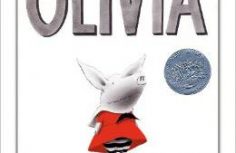FIRST READING: ILLUSTRATIONS – OLIVIA
The purpose of the illustrations is to give you information about the main character, Olivia. Mr. Falconer uses quite a bit of humor in them which both reader and listener will enjoy. As you move through the illustrations, you’ll be talking about Olivia’s personality traits, her likes and dislikes, and her family.
*Page 1 is the page on which the text begins.
Pages 2 – 5:
Meet Olivia.
~What activities do you see Olivia doing?
~What does this tell you about Olivia? (She is very active and likes to do many things.)
~Do you like to do any of the things that Olivia likes to do?
~On pages 4 and 5, who do you think the little piglet might be?
Pages 6 – 7:
~What do you see Olivia doing?
~How are Olivia and you alike? How are Olivia and you different?
Pages 8 – 9:
~What do you notice about Olivia’s clothes? What might this tell you about Olivia?
~On page 8, note Olivia trying to wear a pair of panty hose. Panty hose might need an explanation to your listener.
Pages 10 – 14:
~Where are Olivia, her mother, and brother?
~What can you tell about Olivia from these illustrations? (She likes the beach. She knows how to swim.)
Pages 15 – 17:
~On page 15, how does Olivia seem to be feeling? Why might she be feeling this way?
~What do you think is happening on these pages?
Pages 18 – 20:
~On page 18, what do you see? Does this give you a clue where Olivia, her mother, and her brother might be?
~On page 19, what do you think Olivia is looking at?
~On page 20, what do you see? What might be happening?
Page 21 – 24:
~What do you see on these pages?
~Why might Olivia be sitting on the steps by herself?
Pages 25 – End:
~ What do you see? What do you think is happening?
~Look at the faces of the characters. How are they feeling? Why might they be feeling that way?
~Is the ending happy? Why or why not?
What did we learn about Olivia’s likes and dislikes from the illustrations?
What did we learn about Olivia’s family from the illustrations?
After looking at the illustrations, some questions that occurred to my grandchildren were simple questions, such as:
~Why is there so much red in the illustrations?
~Why does her mother look like she gets mad at her?
Write down any questions that you have to have them handy for the Second Reading of Olivia. After the Second Reading, your listener will discover that sometimes the text will provide the answers to the questions, and sometimes it won’t. When the text doesn’t provide an answer, it can be a learning experience to talk about what questions weren’t answered. Sometimes the author wants the reader to create their own ideas or answers using clues provided in the illustrations and text.
Read more...

